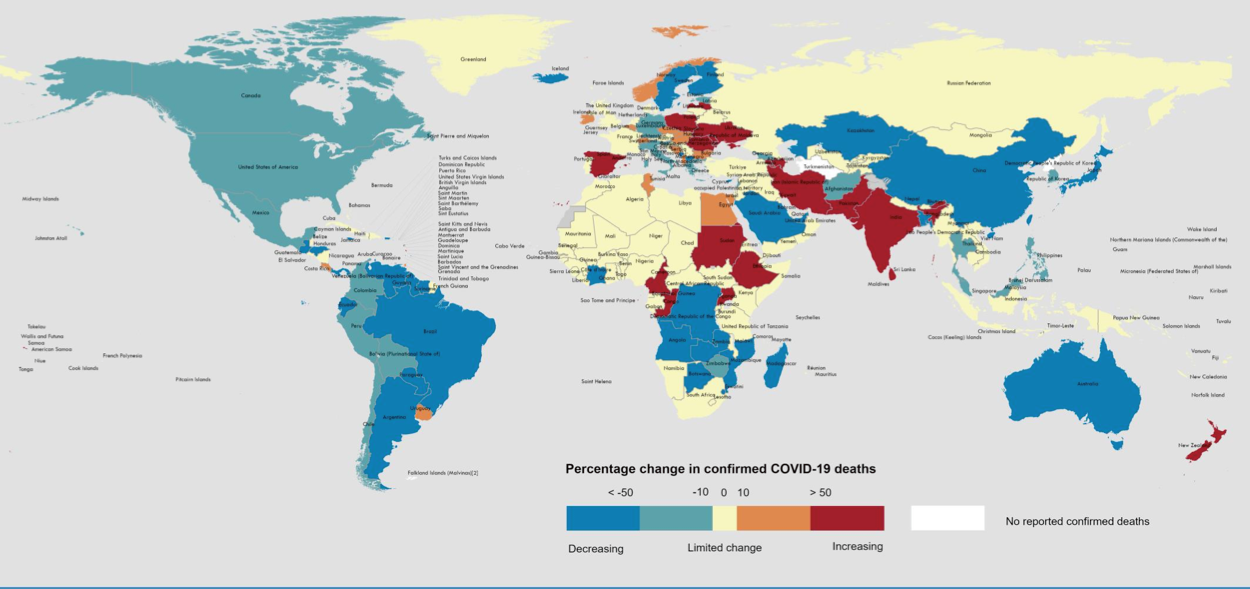
Geneva: Even as the new cases of COVID-19 showed a global decline during the period of March 6 and April 2, 2023, at least 74 (31%) countries reported increases in new cases of 20% or greater during this period as compared to the previous 28-day period.
The World Health Organization though said that to date, there have been no reports of higher severity for the currently circulating variants, although some countries have reported an increase in hospitalizations following a rise in case incidence. However, there have been no reported rises in ICU admissions or deaths due to any of the currently circulating XBB descendent lineages.
India, (34785 versus 4457 new cases; +680%), reported the highest proportional increase in new COVID-19 cases during this period in the World Health Organization’s South-East Asia Region which reported over 46000 new cases, a 289% increase as compared to the previous 28-day period.
At the global level, during the past 28 days (27 February to 26 March 2023), a total of 63 376 new hospitalizations and 2561 new intensive care unit (ICU) admissions were reported. This represents a 0.4% increase in new hospitalizations and a 2% reduction in ICU admissions compared to the previous 28 days (January 30 to February 26, 2023).
Percentage change in confirmed COVID-19 cases over the last 28 days relative to the previous 28 days, as of April 2, 2023 (Source WHO)

In WHO’s South-East Region, seven (64%) of the 11 countries for which data are available reported increases in new cases of 20% or greater. Besides India, Nepal (272 vs 43 new cases; +533%), and the Maldives (72 vs 17 new cases; +324%) showed a high proportional increase in new cases. Indonesia (10 204 new cases; 3.7 new cases per 100 000; +69%), and Thailand (617 new cases; <1 new case per 100 000; -35%) in that order followed India so far as the highest numbers of new cases were concerned in WHO’s South-East Asia Region.
Percentage change in confirmed COVID-19 deaths over the last 28 days relative to the previous 28 days, as of April 2, 2023

So far as COVID-19-related deaths were concerned, the number of new 28-day deaths in WHO’s South-East Region increased by 36% as compared to the previous 28-day period, with 228 new deaths reported. The highest numbers of new deaths were reported from India (106 new deaths; <1 new death per 100 000; +253%), Indonesia (97 new deaths; <1 new death per 100 000; -1%), and Thailand (20 new deaths; <1 new death per 100 000; -44%).
At the country level, the highest numbers of new 28-day cases were reported from the United States of America (626 532 new cases; -39%), the Russian Federation (313 998 new cases; -9%), the Republic of Korea (271 162 new cases; -11%), Japan (202 631 new cases; -61%), and France (193 359 new cases; +98%). The highest numbers of new 28-day deaths were reported from the United States of America (7458 new deaths; -31%), the United Kingdom (2678 new deaths; -7%), Japan (1168 new deaths; -65%), Germany (1090 new deaths; -39%), and the Russian Federation (1014 new deaths; similar to the previous week).
There are currently no reported laboratory studies on markers of disease severity for XBB.1.5, XBB.1.16 or XBB.1.9.1, WHO said. Globally, XBB.1.5 accounted for 47.1% of cases in epidemiological week 11 (13 to 19 March 2023), compared to 39.8% in week 7 (13 to 19 February 2023). To date, XBB.1.5 has been detected in 94 countries.
Currently, WHO is closely tracking one variant of interest (VOI), XBB.1.5, and seven variants under monitoring (VUMs). The VUMs are BA.2.75, CH.1.1, BQ.1, XBF, XBB, XBB.1.16, and XBB.1.9.1. On March 30, 2023, XBB.1.9.1 was added to the list of VUMs due to the F486P mutation (shared with XBB.1.5 and XBB.1.16).
Weekly prevalence of SARS-CoV-2 Variants of Interest and variants under monitoring, week 7 to week 11 of 2023

Between March 6 and April 2, 2023, nearly 3.3 million new cases and over 23 000 deaths were reported, a decrease of 28% and 30%, respectively, compared to the previous 28 days (February 6 to March 5, 2023). As of April 2, 2023, over 762 million confirmed cases and over 6.8 million deaths have been reported globally.
The World Health Organization thought reiterated that current trends in reported COVID-19 cases continued to be underestimates of the true number of global infections and reinfections as shown by prevalence surveys, partly due to the reductions in testing and delays in reporting in many countries.
– global bihari bureau





